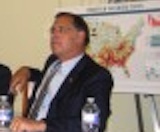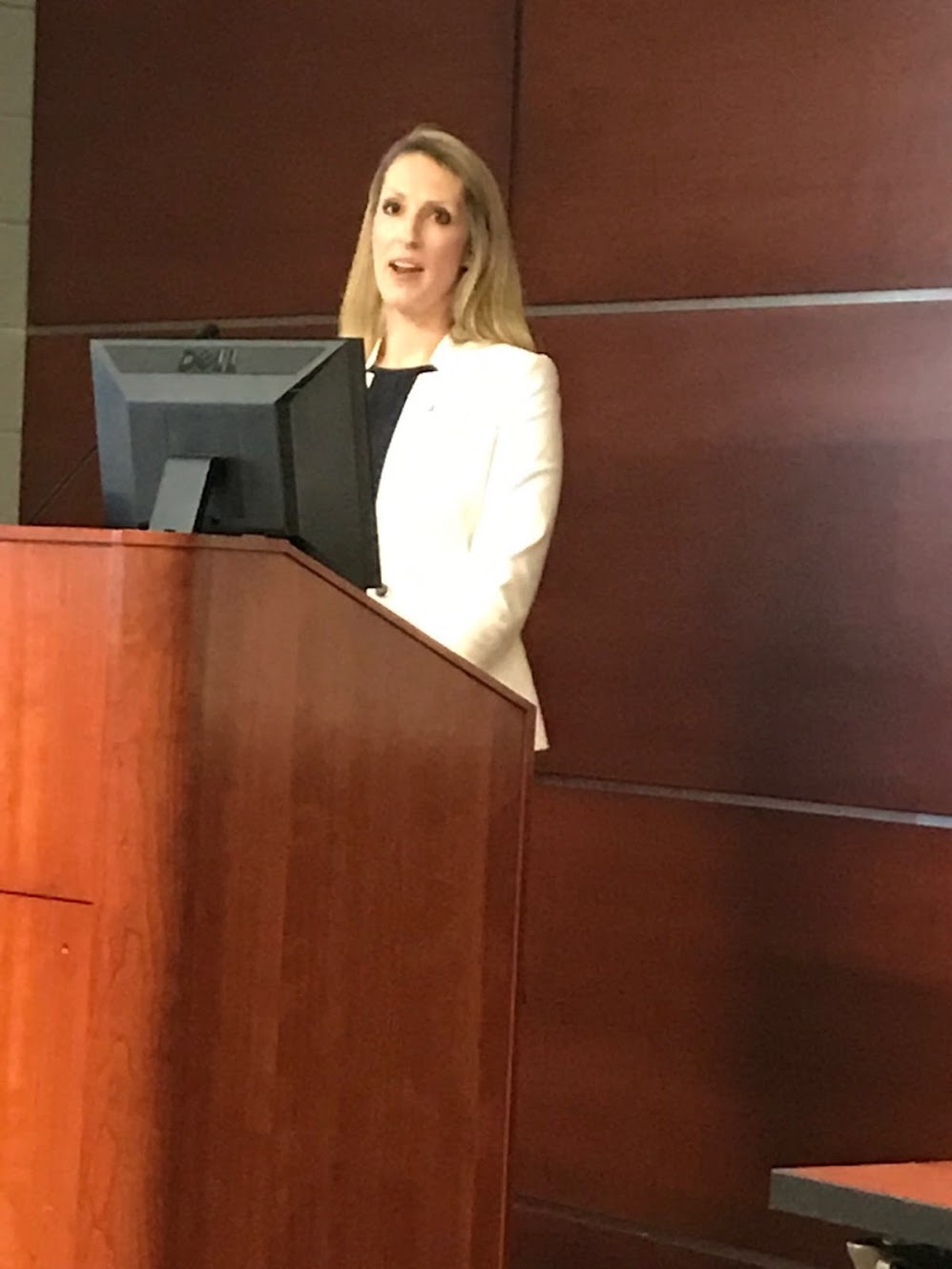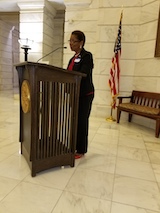Economic Equality Caucus
which advocates for economic equality across the USA.
| Home | Organizational Structure | State Coordinators | Executive Director | Caucus Articles | Memberships | |||||
| "Delta Vision, Delta Voices" | ||||||||||
|
Help Advocate for Economic Progress and Equality. Donate to the Delta Caucus/Economic Equality Caucus. |
||||||||||
Delta Grassroots Caucus Events

Credit Michael Hibblen/ KUAR News, Arkansas Public Radio; Former President Bill Clinton speaking to the Delta Grassroots Caucus on May 2, 2013, at the University of Arkansas Clinton School of Public Service, Little Rock

U. S. Senator John Boozman, Arkansas, at a Delta Grassroots Caucus meeting at the US Capitol

Brad Cole, Executive Director of the Municipal League of Illinois; previously a senior aide to former Republican US Sen. Mark Kirk of Illinois, earlier Mayor of Carbondale, Illinois, veteran Delta regional advocate, speaking at the Delta regional conference in West Memphis, Arkansas on April 26, 2019.

President Bill Clinton makes a comment to Delta Caucus Director Lee Powell at a meeting in Blytheville, Arkansas (in the northeast Arkansas Delta) on Nov. 2, 2014

The Delta Caucus would like to pay tribute to the late, great U.S. Sen. Thad Cochran of Mississippi, a powerful force in the US Senate for decades and a champion for the Delta. Sen. Cochran passed away on May 30, 2019. He spoke to the Delta Caucus on many occasions over the years (he is pictured above speaking to a Caucus event on Capitol Hill in Washington, DC) and his thoughtful, courteous and bipartisan leadership will be sorely missed.

Marcie Lawson, Executive Director, Sikeston, Missouri Regional Chamber and Area Economic Development Corporation, speaking at the Delta regional conference in West Memphis, Arkansas on April 26, 2019.

Alan Gumbel, Greater Memphis Alliance for a Competitive Workforce, Memphis, Tennessee, speaking at the Delta regional conference in West Memphis, Arkansas on April 26, 2019.

Mayor Shirley Washington of Pine Bluff, AR, speaking to the Delta Caucus at the Arkansas Capitol Rotunda in 2017.
Greater Delta Region Partners Report Stagnation or Worsening of Economic and Virus Issues, Nov. 1, 2020
Posted on November 02, 2020 at 12:15 PM
Most of the Greater Delta Region continues to have higher rates of unemployment and Covid-19 cases than most non-Delta areas of their states and most other regions of the country. Latest reports from Delta Caucus grassroots leaders from across the region are mostly negative on both the economic and health care fronts.
Most Delta counties in Arkansas continued to be worse than the state and national averages: Phillips County at 10.1% unemployment rate, Mississippi County at 10.4%, Chicot at 12.4%, Crittenden at 10.2%, Jefferson County at 10.1%, St. Francis at 9.1%, Lee at 9.0%, and Desha at 8.5%.
Mayor Kevin Smith of Helena said “The recession and the pandemic have actually gotten worse recently. The viruses have spiked.”
Arkansas reported on Nov. 2 a record high of 33 deaths, record of 10,420 active virus cases, for a total of 1,958 deaths and 113,057 cases in the pandemic.
The diverse, economically distressed neighborhoods in Little Rock are similar to and adjacent to the east Arkansas heartland Delta, and Pulaski County had a high 9.5% rate.
The Delta Caucus asks all our partners in Arkansas and the other seven Delta states to urge elected officials to provide strong unemployment relief, continue higher SNAP nutrition benefits for the duration of the pandemic, support Medicaid and Medicare funding, and job creation and retention initiatives through the major state and federal agencies like Small Business Administration, Labor, New Markets Tax Credit, CDFIs and other progressive employment programs.
“We would urge our elected officials to base their assessments of the pandemic on science and the facts, and to do everything possible to promote mask wearing and social distancing. We have plenty of people in our region who support President Trump, but we would urge the President to give a realistic assessment of the coronavirus and the economy, which in most areas are both either stagnating or getting worse,” Caucus Director Lee Powell said.
Annette Dove, executive director of the TOPPS nonprofit based in Pine Bluff, said “things are rough here. A lot of people lost their jobs, and we are giving more and more support in food.” TOPPS is providing food to about 400 people now. Jefferson County’s unemployment rate is 10.1% in the September, 2020 data.
Dove said that some people who lost their jobs are also at risk of losing their housing. TOPPS is still functioning, although it closed twice, first when the pandemic broke out and then after a number of infections at a nearby school.
Some east Arkansas counties did fare better than the counties already cited ranging from 8% to 12.4%. Woodruff’s jobless rate was 6.4%, Bradley was 6.1%, and Prairie County had a relatively low rate (for the recession) at 5.8%.
Harvey Joe Sanner, president of American Agriculture Movement of Arkansas based in Des Arc, said there were some bright spots in his local area. For example, a home decor company, Guess and Company, employs 75 people and is doing well. Many small businesses are staying open, and the car lots are doing well–apparently because people want to avoid mass transit during the pandemic. Agriculture in his area was “not rosy” but was looking better.
On the negative side, Sanner said employees as well as residents of a local nursing home tested positive for the virus in the last several days, causing serious concern about a looming spike in the pandemic in their area.
Caucus Director Lee Powell said the reports across the region were largely pessimistic as the virus counts stay too high and a strong recovery is not developing.
Arkansas epidemiologist Jennifer Dillaha was quoted in the Arkansas Democrat-Gazette as saying that the high level of virus transmissions to people who do not follow guidelines about wearing masks and practicing social distancing. Gov. Asa Hutchinson announced on July 16 that residents were required to wear face coverings in public when social distancing could not be achieved, after earlier having not supported a mandate.
Louisiana suffers from unprecedented levels of hunger in the pandemic, unemployment that is still high at 8.1% although lower than the modern-era high of 14.5% in April, 2020. One in 5 adults with children in the state could not afford enough food to eat from mid-August to mid-September.
African Americans and Hispanics suffer disproportionately from the pandemic/recession. Minorities tend to have higher representation in front-line jobs like child care or retail sales and are more likely to have lost their jobs. In Louisiana, blacks make up 30% of the workforce but filed 40% of unemployment insurance claims, according to the nonprofit Louisiana Budget Project.
In the southern Illinois Delta, unemployment has more than doubled in the past year from 3.7% in September, 2019 to 7.7% in September, 2020.
Mississippi’s unemployment rate is 7.1%, Alabama at 6.6% and Kentucky at 5.6% are faring somewhat better.
Michael Pakko of the Arkansas Economic Development Institute reported that “after recovering through the months of May, June and July, continued improvement Arkansas labor markets has slowed.” The unemployment rate was slightly lower in September, declining 0.1 percentage point to 7.3%, but Pakko said there has been no statistically significant change in Arkansas’ unemployment rate since July.
The U.S. unemployment rate which peaked at 14.7% in April, fell by half a percentage point in September, declining from 8.4% to 7.9%.
Back to the top